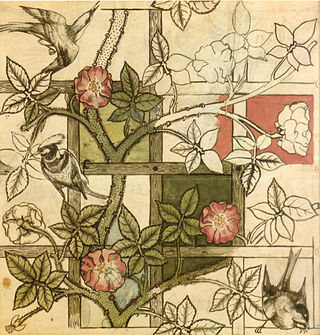
The Arts and Crafts movement was an international trend in the decorative and fine arts that developed earliest and most fully in the British Isles and subsequently spread across the British Empire and to the rest of Europe and America.

The Pre-Raphaelite Brotherhood was a group of English painters, poets, and art critics, founded in 1848 by William Holman Hunt, John Everett Millais, Dante Gabriel Rossetti, William Michael Rossetti, James Collinson, Frederic George Stephens and Thomas Woolner who formed a seven-member "Brotherhood" partly modelled on the Nazarene movement. The Brotherhood was only ever a loose association and their principles were shared by other artists of the time, including Ford Madox Brown, Arthur Hughes and Marie Spartali Stillman. Later followers of the principles of the Brotherhood included Edward Burne-Jones, William Morris and John William Waterhouse.

Sir Edward Coley Burne-Jones, 1st Baronet, was an English painter and designer associated with the Pre-Raphaelite Brotherhood's style and subject matter.

The Royal Birmingham Society of Artists (RBSA) is an art society, based in the Jewellery Quarter in Birmingham, England, where it owns and operates an art gallery, the RBSA Gallery, on Brook Street, just off St Paul's Square. It is both a registered charity, and a registered company.

Morris, Marshall, Faulkner & Co. (1861–1875) was a furnishings and decorative arts manufacturer and retailer founded by the artist and designer William Morris with friends from the Pre-Raphaelites. With its successor Morris & Co. (1875–1940) the firm's medieval-inspired aesthetic and respect for hand-craftsmanship and traditional textile arts had a profound influence on the decoration of churches and houses into the early 20th century.

The Grosvenor Gallery was an art gallery in London founded in 1877 by Sir Coutts Lindsay and his wife Blanche. Its first directors were J. Comyns Carr and Charles Hallé. The gallery proved crucial to the Aesthetic Movement because it provided a home for those artists whose approaches the more classical and conservative Royal Academy did not welcome, such as Edward Burne-Jones and Walter Crane.

Joseph Edward Southall RWS NEAC RBSA was an English painter associated with the Arts and Crafts movement.

Nelson Ethelred Dawson was an English artist and member of the Arts and Crafts movement.
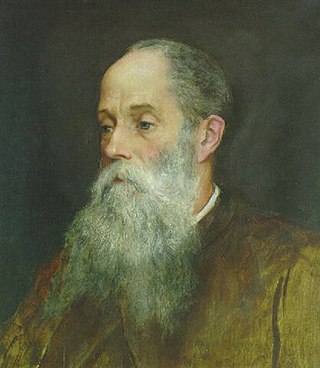
John Roddam Spencer Stanhope was an English artist associated with Edward Burne-Jones and George Frederic Watts and often regarded as a second-wave pre-Raphaelite. His work is also studied within the context of Aestheticism and British Symbolism. As a painter, Stanhope worked in oil, watercolor, fresco, tempera, and mixed media. His subject matter was mythological, allegorical, biblical, and contemporary. Stanhope was born in Cawthorne, near Barnsley, Yorkshire, England, and died in Florence, Italy. He was the uncle and teacher of the painter Evelyn De Morgan and encouraged then unknown local artist Abel Hold to exhibit at the Royal Academy, which he did 16 times.

Charles Edward Hallé (1846–1914), sometimes given as Edward Charles Hallé, was an English Victorian painter and gallery manager. He was a painter of history scenes, genre scenes, and portraits.
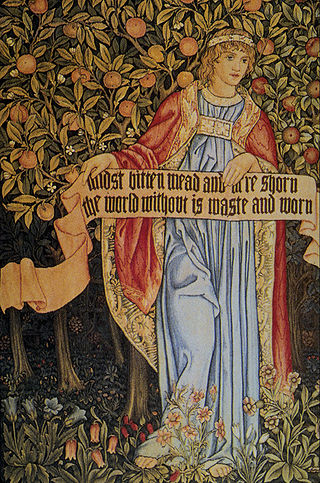
John Henry Dearle was a British textile and stained-glass designer trained by the artist and craftsman William Morris who was much influenced by the Pre-Raphaelite Brotherhood. Dearle designed many of the later wallpapers and textiles released by Morris & Co., and contributed background and foliage patterns to tapestry designs featuring figures by Edward Burne-Jones and others. Beginning in his teens as a shop assistant and then design apprentice, Dearle rose to become Morris & Co.'s chief designer by 1890, creating designs for tapestries, embroidery, wallpapers, woven and printed textiles, stained glass, and carpets. Following Morris's death in 1896, Dearle was appointed Art Director of the firm, and became its principal stained glass designer on the death of Burne-Jones in 1898.

Joseph William Comyns Carr, often referred to as J. Comyns Carr, was an English drama and art critic, gallery director, author, poet, playwright and theatre manager.
The Arts and Crafts Exhibition Society was formed in London in 1887 to promote the exhibition of decorative arts alongside fine arts. The Society's exhibitions were held annually at the New Gallery from 1888 to 1890, and roughly every three years thereafter, were important in the flowering of the British Arts and Crafts Movement in the decades prior to World War I.

A number of Wurlitzer theatre organs were imported and installed in the United Kingdom in the period from 1925 to just before the Second World War (1939–45).

Pygmalion and the Image is the second series of four oil paintings in the Pygmalion and Galatea series by the Pre-Raphaelite artist Edward Burne-Jones which was completed between 1875 and 1878. The two collections may be seen below, in the Gallery, the first being now owned by Lord Lloyd Webber, and the second housed at the Birmingham Museum & Art Gallery. This article deals with an appraisal of the second series.

The Golden Stairs is one of the best-known paintings by the Pre-Raphaelite artist Edward Burne-Jones. It began in 1876 and was exhibited at the Grosvenor Gallery in 1880.
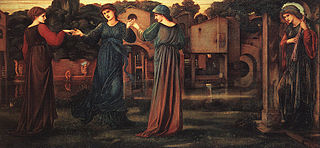
The Mill is an Aesthetic Movement, Renaissance-inspired oil on canvas painting completed by Edward Burne-Jones in 1882. The painting's main feature is three women dancing in front of a mill pond on a summer evening, with a vague wooded landscape spanning the background. The Mill is an oil on canvas painting. It is 91 centimetres (36 in) in height, and 197 centimetres (78 in) in width.

Love Among the Ruins is a painting by English artist Edward Burne-Jones which exists in two versions, a watercolour completed in 1873 and an oil painting completed in 1894. It depicts a man and a woman amid ruined architecture. The work is a synthesis of influences from the Pre-Raphaelite, Symbolist and Aesthetic art movements. The ambiguous scene without a clear narrative is considered one of Burne-Jones' best works.

The Wheel of Fortune is an oil painting on canvas by the British Pre-Raphaelite painter Edward Burne-Jones, made from 1875 to 1883. The painting combines classical and medieval themes to present an allegory of the vagaries of life, a vanitas, with individual lives elevated or cast down as the wheel of fortune turns. Burne-Jones commented: "My wheel of Fortune is a true-to-life image; it comes to fetch each of us in turn, then it crushes us." The prime version has been in the collection of the Musée d'Orsay in Paris since 1980.
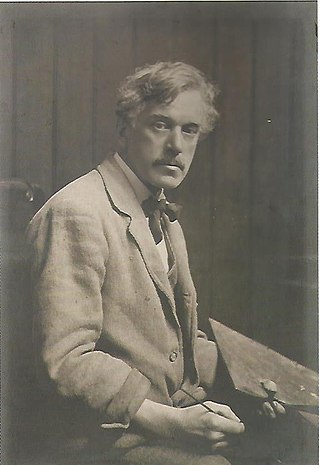
Edward Stott was an English painter of the late Victorian to early twentieth century period. He trained in Paris under Carolus Duran and was strongly influenced by the Rustic Naturalism of Bastien-Lepage and the work of the Impressionists, which he married with the English landscape tradition of John Linnell and Samuel Palmer. In the mid-1880s he settled in rural Sussex where he was the central figure in an artistic colony. His forté was painting scenes of domestic and working rural life and the surrounding landscapes often depicted in fading light. Stott's work achieved critical and commercial success at home and in Europe in his lifetime but his style of painting became unfashionable in the aftermath of the Great War and much of his work is now neglected and unconsidered.



















